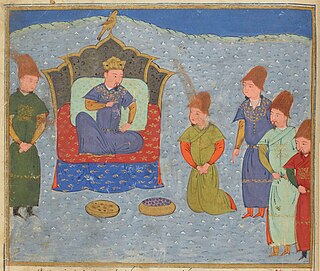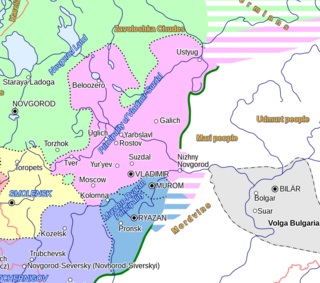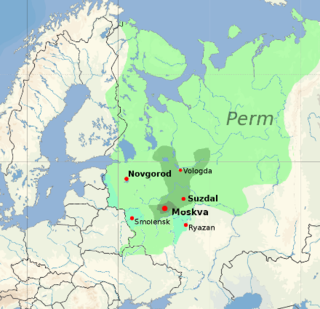
Year 1237 (MCCXXXVII) was a common year starting on Thursday of the Julian calendar.

The Mongol Empire invaded and conquered much of Kievan Rus' in the mid-13th century, sacking numerous cities including the largest such as Kiev and Chernigov. The Mongol siege and sack of Kiev in 1240 is generally held to mark the end of Kievan Rus' as a distinct, singular polity. Many other Rus' principalities and urban centres in the northwest and southwest escaped destruction or suffered little to no damage from the Mongol invasion, including Galicia-Volhynia, Novgorod, Pskov, Smolensk, Polotsk, Vitebsk, and probably Rostov and Uglich.

The Golden Horde, self-designated as Ulug Ulus was originally a Mongol and later Turkicized khanate established in the 13th century and originating as the northwestern sector of the Mongol Empire. With the division of the Mongol Empire after 1259, it became a functionally separate khanate. It is also known as the Kipchak Khanate or as the Ulus of Jochi, and it replaced the earlier, less organized Cuman–Kipchak confederation.

Iván I Danilovich Kalitá was Grand Prince of Moscow from 1325 to at least 1340, and Grand Duke of Vladimir from 1332 until at least 1340.

Batu Khan was a Mongol ruler and founder of the Golden Horde, a constituent of the Mongol Empire. Batu was a son of Jochi, thus a grandson of Genghis Khan. His ulus ruled over the Kievan Rus', Volga Bulgaria, Cumania, and the Caucasus for around 250 years.

Vladimir-Suzdal, formally known as the Principality of Vladimir-Suzdal or Grand Principality of Vladimir (1157–1331), also as Vladimir-Suzdalian Rus', was one of the major principalities that succeeded Kievan Rus' in the late 12th century, centered in Vladimir-on-Klyazma. With time the principality grew into a grand principality divided into several smaller principalities. After being conquered by the Mongol Empire, the principality became a self-governed state headed by its own nobility. A governorship of principality, however, was prescribed by a jarlig issued from the Golden Horde to a Rurikid sovereign.

The Principality or, from 1253, Kingdom of Galicia–Volhynia, historically known as the Kingdom of Ruthenia, was a medieval state in Eastern Europe which existed from 1199 to 1349. Its territory was predominantly located in modern-day Ukraine, with parts in Belarus, Poland, Moldova, and Lithuania. Along with Novgorod and Vladimir-Suzdal, it was one of the three most important powers to emerge from the collapse of Kievan Rus'. The main language was Old East Slavic, the predecessor of the modern East Slavic languages, and the official religion was Eastern Orthodoxy.

Yuri II, also known as George II of Vladimir or as Georgy II Vsevolodovich, was the fourth Grand Prince of Vladimir who presided over the Principality of Vladimir-Suzdal at the time of the Mongol invasion of Kievan Rus'.

From the 1220s into the 1240s, the Mongols conquered the Turkic states of Volga Bulgaria, Cumania and Iranian state of Alania, and various principalities in Eastern Europe. Following this, they began their invasion into Central Europe by launching a two-pronged invasion of then-fragmented Poland, culminating in the Battle of Legnica, and the Kingdom of Hungary, culminating in the Battle of Mohi. Invasions were also launched into the Caucasus against the Kingdom of Georgia, the Chechens, the Ingush, and Circassia though they failed to fully subjugate the latter. More invasions were launched in Southeast Europe against Bulgaria, Croatia, and the Latin Empire. The operations were planned by General Subutai (1175–1248) and commanded by Batu Khan and Kadan, two grandsons of Genghis Khan. Their conquests integrated much of Eastern European territory into the empire of the Golden Horde. Warring European princes realized they had to cooperate in the face of a Mongol invasion, so local wars and conflicts were suspended in parts of central Europe, only to be resumed after the Mongols had withdrawn. After the initial invasions, subsequent raids and punitive expeditions continued into the late 13th century.

The Principality of Ryazan, later known as the Grand Principality of Ryazan, was a principality from 1129 to 1521. Its capital was the city of Ryazan, now known as Old Ryazan, which was destroyed in 1237 during the Mongol invasions. The capital was moved to Pereyaslavl-Ryazansky, later renamed Ryazan.

The Principality of Murom, also referred to as the Murom-Ryazan Principality until the mid-12th century, was a principality with its capital in Murom, now in Vladimir Oblast, Russia. Murom lay in an area that was strongly Finnic and for much of its medieval history, located in the homeland of the Muromians. In 1392, it was incorporated into the Grand Principality of Moscow.
The Tale of the Destruction of Ryazan (by Batu) (Russian: Повесть о разорении Рязани Батыем, romanized: Povest' o razorenii Riazami Batyem) is a Russian literary work about the capture of the city of Ryazan by the Mongols in 1237. It is compiled from earlier manuscripts.

The Principality of Moscow or Grand Duchy of Moscow, also known simply as Muscovy, was a principality of the Late Middle Ages centered on Moscow. It eventually evolved into the Tsardom of Russia in the early modern period. The princes of Moscow were descendants of the first prince Daniel, referred to in modern historiography as the Daniilovichi, a branch of the Rurikids.

The siege of Kiev by the Mongols took place between 28 November and 6 December 1240, and resulted in a Mongol victory. It was a heavy morale and military blow to the Principality of Galicia–Volhynia, which was forced to submit to Mongol suzerainty, and allowed Batu Khan to proceed westward into Central Europe.
The Grand Prince of Vladimir, also translated as Grand Duke of Vladimir, was the title of the ruler of Vladimir-Suzdal, which was passed to the prince of Moscow in 1389.

The siege of Kozelsk was one of the main events of the Western (Kipchak) March of the Mongols (1236–1242) and the Mongol invasion of Kievan Rus' (1237–1240) at the end of the Mongol campaign in northeastern Kievan Rus' (1237–1238). The Mongols laid a siege in the spring of 1238 and eventually conquered and destroyed the town of Kozelsk, one of the subsidiary princely centers of the Principality of Chernigov.
The Siege of Kolomna during December 1237–January 1238 was part of the Mongol invasion of Kievan Rus'. Following the Battle of Voronezh River in December 1237, Yuri II of Vladimir sent both of his sons with "all his men" and Voivode Yeremey to defend the fortress of Kolomna, which was on the border to the Wild Fields.

The siege of Vladimir in February 1238 was part of the Mongol invasion of Kievan Rus'.
The Mongol siege, capture and sack of Chernigov, capital of the Chernigov Principality, occurred on 18 October 1239 during the westward expansion of the Mongol Empire. It was part of the 1237–1242 Mongol invasion of Kievan Rus'.













